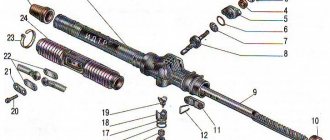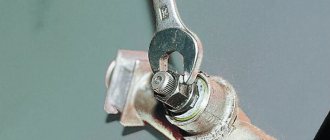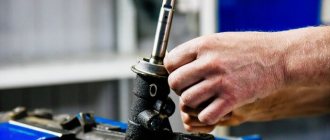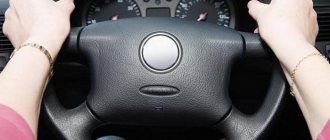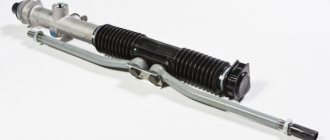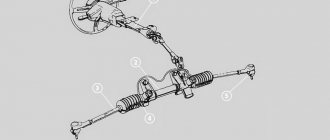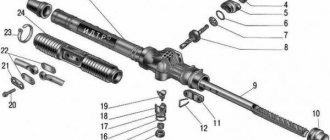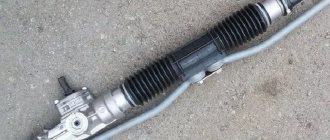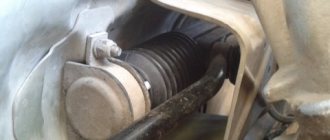From the first time I drove this car, I noticed that the steering wheel was impossible to turn. I've been driving for a long time and don't understand why someone said that the steering doesn't work, the steering wheel play adjustment bolt is too tight.
BUT everything was fine with the gearbox. The problem was not with him!
I got up to see what was wrong with my pendant. After carrying out diagnostic manipulations, it turned out that the thrust bushings had become unusable. On some levers, one might say, they were not there. They are not expensive per coin and I replaced them, but not all of them, but the dead ones. To be honest, it’s disgusting to replace them with a sledgehammer and a bolt. After such a partial repair, the steering wheel turns much easier. But still he did not reach the ideal. I was wondering what else could be the problem. After driving it a little, I noticed that if you put the steering wheel level, the right wheel looks a little bit like the steering wheel compared to the left one...
Hence the conclusion is that the collapse of similarity has been refuted. Well, going to the station and paying is not an option for me, so I roughly set the wheel myself to approximately the correct position (adjustment article) As a result, the moving steering wheel can be turned with one finger, but to turn it into the desired position, you need to connect a second one hand to turn. OK it's all over Now!
Until recently, the car had a very narrow steering wheel; turning the wheels in place was not particularly difficult (yes, the steering wheel is small, but on other Zhiguli cars with the same steering wheels, steering is much easier). In addition, the steering wheel did not return during reverse and always remained in the position in which you left it - the car drove as if on tracks)) After that, no one remembered the steering wheel, but I definitely remembered it at the moment when I bought it, the steering wheel turned very easily. I thought about the gearbox, but now it’s time to replace it (the steering play could no longer be adjusted), at the same time the steering rods and wheel bearings were replaced (the ball joints were changed a year ago) and a similar collapse occurred.
It would seem that everything is new: the steering should have become easier, but it turned out the opposite. Moreover, the game was tense. We started digging further and removed the steering shaft bushing, and miraculously, the steering wheel immediately turned as it should! Upon inspection, the essence of the problem became clear: the shaft is blocked by the bushing in a place where it should not even touch it (all this can be seen in the photo below).
The problem was fixed by centering the shaft inside the bushing. It is horizontally centered thanks to the wide "binocular" holes, and unfortunately there is no vertical centering. Perhaps this is why (apart from the passive safety factor) the designers abandoned the solid shaft, and later began installing a composite shaft with a driveshaft on the Model 07.
Then we lubricated the rubbing parts, assembled everything and installed a standard-diameter steering wheel from the 05 VAZ model. As a result, the steering became much easier, and the steering wheel finally became informative!
If a car at some point cannot turn in the desired direction, then it cannot be called safe. This applies to all cars, and the VAZ 2106 is no exception. The six steering system is very complex. The heart of the system is the steering, which, like any other device, deteriorates over time. Fortunately, a car enthusiast can easily change it himself. Let's find out how it's done.
Stiff steering on VAZ 2107
VAZ cars, which are classic models, are distinguished by pleasant reliability.
This also applies to the steering mechanism. It is quite complex, but its design allows you to maneuver and ensure reliable vehicle control even in the most difficult road conditions.
The modernization process led to the installation of a composite shaft and a safety column. Due to the size of the steering wheel, the driver makes the necessary maneuvers without any problems. From lock to lock, it takes 3.5 turns to turn the steering wheel completely. The force from the steering column is transmitted to the drive via a composite shaft.
The current steering mechanism on the VAZ 2107, a product of the Volga Automobile Company, is quite informative and does not allow the driver to get tired during long trips. There are certain difficulties when turning in a parking lot, but as soon as the car begins to move, the resistance weakens and turning the steering wheel becomes easier.
There is one more nuance - when the steering mechanism is working properly, there is a slight play. But its limit value complies with the traffic rules. This is due to the fact that there are steering rods on the VAZ 2107 and an impressive number of elements in the gearbox.
In general, the steering of the 7 can be considered reliable.
Let's sum it up
As you can see, there are more than enough sources of extraneous noise in the power plant.
Some of them do not cause significant harm even with prolonged use of the car without eliminating them.
Some reasons are more serious, but at least allow you to take the car for repairs.
And the causes of knocking in the engine associated with the crank mechanism and the cylinder-piston group are very serious and are a harbinger of expensive and time-consuming repairs.
By clicking on the link, you will learn about other causes of extraneous noise in a car.
In this situation, it is very important to take action in time. Good luck.
Stiff steering on VAZ 2107
Rods, bipod, hinges - where is it all?
The main parts and steering components of the VAZ-2107 and other rear-wheel drive models are shown in the figure below. To understand what is faulty, let’s remember “who is who”. You also need to remember that breakdowns of steering parts and assemblies are very dangerous and, in most cases, lead to serious accidents! For example, if the steering rod breaks, the front wheels lose contact with the steering wheel and the car flies into a ditch or into oncoming traffic. To prevent this from happening, let's check the condition of the steering of our “classic”.
Steering VAZ-2107
1 – lateral thrust. 2 – bipod. 3 – medium traction. 4 – Pendulum lever. 5 – adjusting clutch. 6- lower ball joint of the front suspension. 7 - right steering knuckle. 8- upper ball joint of the front suspension. 9 - right steering knuckle lever. 10- bracket for the pendulum arm. 11- bearing of the upper steering shaft. 12, 19 - steering shaft mounting bracket. 13- pipe of the steering shaft mounting bracket. 14- Upper steering shaft. 15 - steering gear housing. 16- intermediate shaft. 17- facing casing. 18- steering wheel. 20- fixing plate of the front bracket. Pinch bolt for fastening the universal joint. 22- body spar.
Inspection and testing of the VAZ-2107 steering
You need to check your steering if your car has the following signs: -increased play (free play) of the steering wheel; -knocks in the area of the front wheels; - difficult (tight) rotation of the steering wheel. It is better and more convenient to perform all work in an inspection ditch or on a lift. Be sure to invite an assistant; you can’t handle the check alone. Before work, the car must be thoroughly washed from below. Set the steering wheel to the position for driving in a straight line. Turning the steering wheel left and right, we check one by one: - the play of the steering wheel along the rim is 18 – 20 mm; - there should be no knocking in the hinges and joints; - the fastenings of the steering gear housing and the pendulum lever are not loose; - there is no play in the ball joints of the rods and in the bracket of the pendulum arm, and the bipod does not move in the axial direction; - steering force does not exceed 20 kgf; - the adjusting couplings of the side rods are securely secured with clamps; -all protective caps and rubber covers have no cracks or tears.
Ball joints of steering rods are considered to be in good condition if the axial movement (along the axis of the fingers) is no more than 1.5 mm. When you press the mount on the hinge, you should feel the resistance of the spring.
Trouble-shooting
Loose threaded connections must be tightened, damaged and worn components and parts must be replaced. The most common parts to be replaced are tie rods with joints and a pendulum arm. A stiff steering wheel or knocking noise in the steering mechanism can be eliminated by adjusting the worm gearing . After replacing the rods, you need to adjust the camber and toe angles of the wheels.
Watch the video on steering linkage diagnostics
Extraneous knocking noises when the engine is idling
Let's look at the causes of knocking in the engine under different operating modes.
First, let's look at the reasons for its occurrence at idle.
Here you first need to determine the behavior of the knock in the future.
Thus, a slight knocking sound in the engine at idle, emanating from the middle part of the engine, having a uniform intensity, while the sound intensity decreases somewhat with increasing speed, presumably indicates that small third-party parts or debris from parts have entered the cylinder.
This problem is eliminated by removing the block head and removing foreign objects.
The same knock, but increasing with increasing speed, signals wear of the cylinder-piston group, damage to the piston skirts due to overheating.
This malfunction can only be eliminated by replacing the cylinder-piston group.
The appearance of a similar noise, but with half the intensity, and heard in the upper part of the unit indicates a violation in the operation of the timing belt.
If a knock is present not only in idle, but also in other modes, this indicates wear on the camshaft and a violation of valve adjustment.
If the thermal gap is adjusted using hydraulic compensators, then the knocking noise as the speed increases, as a rule, decreases.
But this indicates a malfunction of the hydraulic compensators.
Problems with the cylinder head are solved by removing the valve covers, determining the source of the sound, replacing worn elements or adjusting the clearance.
A uniform knocking sound, significantly increasing with increasing speed, if it comes from below, this indicates the destruction of the balancer shaft bearings, the beginning of the destruction of the connecting rod liner, and deformation of the connecting rod itself.
These are some of the most dangerous causes of noise.
If at idle you hear an uneven sound that completely disappears as the speed increases, this is a signal of problems with the bearings of the engine attachments, for example, a malfunction of the pump bearing.
A muffled, uneven knock that appears at idle and disappears as the speed increases indicates that the permissible oil level has been exceeded due to working fluids or fuel getting into it. In this case, an internal breakdown of the cylinder head gasket occurred and antifreeze began to flow into the oil.
All of the above malfunctions, except for destruction of the connecting rod bearings and balance shafts, are generally not very dangerous; the driver has the opportunity to deliver the car under its own power to a service center or garage.
On the VAZ 2107 the steering wheel has become very difficult to turn, what is the reason?
The reason is poor nutrition, you need to eat better.
Did it spin easily at first? There's nothing to influence the effort
the reason is either in the trapezoid or in the seams, or the pendulum or gearbox has screwed up. there seem to be no others)
the pendulum1 jammed, then the ball ends, etc.
change the swing arm
pour oil into the gearbox and then the ground - I see you have a beha 07)))—
Incorrect camber, steering gear (locked pin is tightly tightened).
This happened to me once at a classic too. In the morning in winter, the steering wheel turned in one direction easily, but back with difficulty. The reason turned out to be banal - somehow there was water in the steering column housing. in the morning it turned to ice.
Perhaps the steering rack has fallen off, or is clogged, either get a new one or clean the old one, the price is about the same
Check the grease in the steering gear.
They changed the wheels to “wider” ones and forgot to inflate them
The rack may be too tight! Loosen her up!
Knock of connecting rod bearings
Typically, the knock of connecting rod bearings is sharper than the knock of the main bearings. It can be heard at idle and with the gearshift lever in neutral. The knocking noise increases with increasing crankshaft speed. To determine which of the four connecting rods turned out to be defective, it is necessary to exclude one of the cylinders from operation in turn, removing the high voltage wire from the spark plug. The reasons that cause knocking of connecting rod bearings are very similar to the previous ones: incorrect ignition timing; low quality oil; large gaps between the journals (now connecting rods) of the crankshaft and the bearings; ovality or taper of the connecting rod journals; non-parallelism of the axes of the upper and lower connecting rod heads. And again you have to go to a service station, since the engine will have to be disassembled.
How to remove steering play on a VAZ 2107
You should begin work by checking the tightness of the threaded connections of the steering mechanism and the condition of the steering rods (tips). Bent rods or worn tie rod joints must be replaced. To do this, you will have to use a puller and a 22mm wrench. You should not try to align the rods or repair the ends. For safety reasons, these parts should always be replaced with new ones. Next, you should check the condition of the pendulum and the adjustment of the worm gear. Worn pendulum bushings must be replaced with new ones. To do this, you need to unscrew the steering rods from it (use a 22mm wrench and a puller) and remove the pendulum from the car by unscrewing the mounting bolts. Clamp the pendulum in a vice, remove the cotter pin and unscrew the adjusting nut. Once the nut is unscrewed, you can disassemble the pendulum and replace the worn bushings with new ones. When assembling the pendulum, it is necessary to tighten the adjusting nut so that its bipod rotates with a force of 1-2 kilograms. If all parts are replaced or in good condition, and the threaded connections are tightened, the VAZ 2107 steering play is adjusted by adjusting the steering gearbox. To do this, you will need a 19 mm wrench and a powerful slotted screwdriver. The adjustment is carried out as follows:
How to return the sound signal yourself
If the steering wheel needed to be removed because the sound signal stopped working, then the removal process is carried out in the same sequence as previously described. Next you will need to do the following:
- Be sure to check the steering play, which should not exceed 5 C, and the copper contact of the horn. The contact is located on the steering column; if traces of oxidation or other types of contaminants are noticed on its surface, they are carefully removed;
- Next, the connecting fasteners on the back of the steering wheel are unscrewed so that the entire panel assembly can be removed, including the contact plate;
- The removed steering wheel with the panel should be placed on a table or workbench to find the failed contact. The latter is most often the main reason why the sound signal disappears;
- if the contact is disconnected, you just need to solder it back to its original place and install the panel with the steering wheel.
At this point, the process can be considered complete, and it’s hard to believe that such work is difficult for car enthusiasts, even with little experience. And with an Internet connection at hand, if necessary, you can watch a training video at any time, which will further simplify the process of replacing the steering wheel and help you find out why the sound signal in the VAZ-2107 began to disappear.
How to remove steering play on a VAZ 2107
You should begin work by checking the tightness of the threaded connections of the steering mechanism and the condition of the steering rods (tips). Bent rods or worn tie rod joints must be replaced. To do this, you will have to use a puller and a 22mm wrench. You should not try to align the rods or repair the ends. For safety reasons, these parts should always be replaced with new ones. Next, you should check the condition of the pendulum and the adjustment of the worm gear. Worn pendulum bushings must be replaced with new ones. To do this, you need to unscrew the steering rods from it (use a 22mm wrench and a puller) and remove the pendulum from the car by unscrewing the mounting bolts. Clamp the pendulum in a vice, remove the cotter pin and unscrew the adjusting nut. Once the nut is unscrewed, you can disassemble the pendulum and replace the worn bushings with new ones. When assembling the pendulum, it is necessary to tighten the adjusting nut so that its bipod rotates with a force of 1-2 kilograms. If all parts are replaced or in good condition, and the threaded connections are tightened, the VAZ 2107 steering play is adjusted by adjusting the steering gearbox. To do this, you will need a 19 mm wrench and a powerful slotted screwdriver. The adjustment is carried out as follows:
Detonation - what is it?
If the “fingers” knock during acceleration, this indicates detonation in the engine. This is the name given to an instantaneous and very destructive in its force explosion of any flammable substance after an impact or activation of a detonator. This is the definition according to Ushakov’s dictionary. Detonation of flammable substances for car engines is the rapid burning out of a mixture of gasoline and air. Occurs when the engine operates under load at low speeds and low-quality fuel. This process is accompanied by knocking, vibration, and increased temperature. As a result, the “fingers” knock during acceleration (including the VAZ-2112).
Causes of steering play in VAZ 2107
If you notice unacceptable play in the VAZ 2107 steering wheel, the reasons may be as follows:
- The central nut securing the steering wheel to the axle is not tightened;
- the nut securing the steering column to the gearbox is loosened;
- The worm gear of the steering mechanism is not adjusted;
- the steering pendulum bushings are worn out;
- The tie rods are damaged or their ends are worn.
All of these problems require immediate intervention. Otherwise, the steering mechanism may fail and the car will lose control.
A little about the camshaft
Fortunately for many, the camshaft is not one of the components that are positioned as capricious, often and quickly failing. The resource largely depends on the quality of the part and operating conditions.
The camshaft has a life limit. Uninterrupted operation can last from 50 to 150 thousand kilometers. These are fairly average indicators, since each situation is still individual. Active work is already underway to remove this element from the engine design. Moreover, experts say that in the future the camshaft may completely cease to be part of the engine. It will be replaced by electromagnetic actuators.
It is difficult to say how effective and realistic this will be in the near future. Plus, some skeptics doubt the correctness of the transition from a mechanical part to a computer-controlled actuator.
Purpose and necessary checks of the vehicle control system
The transmission of force to the rotary arms from the steering mechanism is carried out using rods, which are part of the so-called trapezoid. This node consists of:
- gearbox;
- long rod;
- pendulum lever;
- two long tips;
- two short tips;
- two clamping devices with tie clamps.
The main malfunctions of the control system in VAZ models. Controllability, comfort and safety of movement depend on the listed parts.
Therefore, increased attention should be paid to monitoring their condition and the schedule of periodic inspections should not be violated. Some people prefer to trust service station technicians, but if you look into it, such an operation is quite doable at home. For this purpose, the presence of an inspection hole or overpass will be sufficient. Next we examine:
- condition of rubber boots;
- axial movement of fingers;
- presence of cracks;
- hinges for gaps;
- attaching the pendulum to the body.
Next you need to check the steering play. When swaying left and right, free play is allowed no more than 2 cm. Press the brake pedal and experience the ease of movement of the steering wheel - it should rotate relatively easily.
Sound diagnostics
If a problem arises that the engine is knocking, as already said, it is first of all important to determine the nature of the knock, as well as the location of its occurrence.
Some of the reasons can be diagnosed without disassembling the power plant.
Thus, a special device - a technical phonendoscope - will allow you to more accurately determine the location of the noise.
Using it, the engine is listened to and it is determined in which mechanism or system malfunctions have occurred.
You can also use more advanced equipment, for example, a motor tester.
A simple procedure will allow you to determine the destruction of the connecting rod liner.
It is done like this: with the engine running, when a loud knocking noise appears, the high voltage wire is removed from the spark plug one by one on each cylinder.
If the fault lies in the connecting rod bearing, then disconnecting the wire on the cylinder that has the problem will significantly reduce the knocking noise.
If noise occurs, when there is a suspicion of destruction of the bearing of any attachment, you can determine which equipment has problems by disconnecting their drive from the on-board network.
Installing power steering
If a motorist wants to install power steering on a VAZ-2107 with his own hands, which the manufacturer did not consider necessary to install in one of the most budget cars in the whole world, he can take one of two possible paths. Firstly, you can select the optimal steering rack that has power steering and then decide on its further location in the car. True, such an action will require enormous labor and money. Secondly, which is more expedient, you can buy a ready-made kit at an auto parts store that allows you to perform all possible most useful manipulations on the stationary steering rack.
The purchased power steering for a VAZ-2107 will consist of many parts: a pump, a pulley, a steering gear, a hydraulic cylinder, an expansion tank and a hose system.
To install power steering on a VAZ-2107, you need to start with a pump, through which pumping is carried out and a certain pressure is created in the unit. This pump must be placed on the cylinder block, since it will operate due to a belt drive. The next step is to determine where to install the crankshaft pulley. Then the steering gear is replaced. The car owner should check the size of the purchased device in advance, since it will most likely differ from the factory analogue, which may require modification of the installation location of the device.
When installing power steering in your car, you should pay close attention to the hydraulic cylinder, which should be located in the car according to the instructions. Further modernization consists of the location of the expansion tank and the sequential connection of a set of parts with high-pressure hoses. The installed reservoir must be equipped with a special fluid intended directly for the power steering. As a result of the manipulation, it is worth pumping the system.
Deformation of the protective shield - will pliers help?
The brake disc is protected from dirt and foreign objects by a metal shield about 0.3 mm thick. There are situations when, under mechanical stress, this part becomes deformed and begins to touch the brake caliper or disc, causing a metallic grinding noise to appear. This happens especially often when driving on gravel roads or off-road.
In such a situation, it is necessary to remove the wheel, inspect the protective part and, if deformation is detected, straighten it using pliers or a screwdriver. This procedure can be done by any car owner.
In addition, a foreign body, for example, a stone, wire, or a piece of a tree branch, can get between the protective shield and the disc. In this case, an unpleasant squeak will also appear. To remove an object, you can first try driving the car back and forth while simultaneously twisting the steering wheel in different directions. Carry out the procedure several times. In most cases, this will lead to the object removing itself and the grinding noise disappearing. If the method still does not help, you need to remove the wheel and manually remove the foreign object.
Turn the steering wheel hard
- Please log in to reply.
#121 alex_slobodka
- Users
- 49 messages
- Registration 16-November 12
- Top
- Complaint
#122 Mountain Master
- From: Sevastopol
- Car: VAZ-21041 1.6i
More than a quarter of a century behind the wheel - Sound pro-audio Now - new Russian.
- Top
- Complaint
#123 alex_slobodka
- Top
- Complaint
#124 Dermart 3
- Top
- Complaint
#125 andron1313
The balls are new, also restored, they were changed a week earlier, everything worked fine, it’s either a trapezoid or a pendulum
- Top
- Complaint
#126 Yurij
- Top
- Complaint
#127 Blade
Hello, the problem is that it’s hard to turn the steering wheel left and right. On diagnostics, the ball ends were normal, but the steering shaft itself, where it enters the gearbox when rocking up and down, has play; should the gearbox be changed or can you get by with a repair kit? Pendulum on bearings
- Top
- Complaint
#128 igor
there is play in the gearbox when rocking up and down
- Top
- Complaint
#129 Bludik777
- Top
- Complaint
#130 Yurij
- Top
- Complaint
#131 Mountain Master
- From: Sevastopol
- Car: VAZ-21041 1.6i
More than a quarter of a century behind the wheel - Sound pro-audio Now - new Russian.
- Top
- Complaint
#132 Vadim Joker
- Top
- Complaint
#133 Metz
Vadim Joker, Hang the front wheels (so that they hang in the air) and turn the steering wheel.. If it turns easily, then the problem is in the supports, camber, and tire pressure.. and maybe in the tires themselves (since it is unknown what you have there and in what condition) If the tires are not evenly worn (if they are worn out from the middle, they will also affect the lightness of the steering) The balder the tires, the harder the steering wheel turns (from my own experience)
If when hanging it is still tight, then only: steering column, gearbox, pendulum, trapezoid. You need to check each unit separately, for example, remove the steering linkage and twist everything separately, thereby checking how easily everything turns, I think that in 90% of cases this way you can determine where it is sticking.
- Top
- Complaint
#134 Vadim Joker
Vadim Joker, Hang the front wheels (so that they hang in the air) and turn the steering wheel.. If it turns easily, then the problem is in the supports, camber, and tire pressure.. and maybe in the tires themselves (since it is unknown what you have there and in what condition) If the tires are not evenly worn (if they are worn out from the middle, they will also affect the lightness of the steering) The balder the tires, the harder the steering wheel turns (from my own experience)
If when hanging it is still tight, then only: steering column, gearbox, pendulum, trapezoid. You need to check each unit separately, for example, remove the steering linkage and twist everything separately, thereby checking how easily everything turns, I think that in 90% of cases this way you can determine where it is sticking.
Thanks for the advice. The steering gearbox is new. They set it so that there was alignment and there were no distortions on the spar. When the wheels are up, the steering wheel turns well. It turns out that the whole problem is in the supports ((((((
- Top
- Complaint
#135 ancistr
- Top
- Complaint
#136 Vadim Joker
- Top
- Complaint
#137 Vadim Joker
- Top
- Complaint
#138 Vadim Joker
- Top
- Complaint
#139 dens321
- Top
- Complaint
#140 andron1313
Why do brakes squeak?
At traffic lights you can hear the piercing squeal of brakes of a car stopping next to you.
Moreover, the hotter the weather, the more the brakes of such cars will squeak. Why does this happen, and how to get rid of squeaking brakes? First, I propose to think about why in most cases the front brake pads of a car squeak rather than the rear ones. Rear pads rarely squeak at all. This happens due to the structure of the braking system itself. When you press the brake pedal of a car, the front brake pads are activated first and, so to speak, take the maximum load on themselves, and then the rear ones are connected, and then the intensity of the pressure from the rear brake pads will be significantly less. Only during extreme braking can both circuits of the brake system, front and rear, operate equally. Due to the fact that the maximum braking force is applied to the front circuit, the front brake pads become hotter. And if they are made of poor quality material, your brakes will begin to squeak.
Now we come to squeaking brake pads. If so, you replaced the brake pads and they started squeaking. Don't be alarmed, even the highest quality pads have their own wear-in period. That is, your new brake pads just need to get used to, usually up to 100 kilometers in the city is enough, the upper rough layer of the pad wears out, and the brakes get rid of squeaking. If you have already driven much more than 300 kilometers, and the brakes are squeaking. Then, most likely, you bought low-quality pads. Many car enthusiasts save money by not buying original brake pads, but in vain! The advantage of non-original brake pads is that they are much cheaper. But there are many more disadvantages; I myself once bought non-original pads for my FORD FUSION, but they were of little use. Firstly, they wear out faster, I didn’t have the original for about 12 - 15 thousand kilometers, but the original for 30 - 35 thousand, you feel the difference. Also in the summer, the brakes squeaked when braking hard. And you know, the brake disc wears out faster, but it’s not cheap. Therefore, the next time I bought the original, but they were two and a half times more expensive, but they also lasted two and a half times longer, and the brake efficiency was completely different. So, the brakes squeak! What kind of pads do you have? Original or not? Of course, not the original can be different. Sometimes you find something that’s not even bad, but remember, it won’t be cheap; most likely, the price will be close to the original brake pads.
So why do cheap brake pads squeak? In the not distant past, squeaking brakes were heard on cars much more often than now. The thing is that the old brake pads were made with the addition of gypsum or asbestos. Such pads, when heated (the body of the pad rubs against the surface of the brake disc), produce a squeaking noise. Nowadays, technologies are completely different, so self-respecting manufacturers make brake pads from other materials. Therefore, the pads do not creak, and braking is effective. But there are also manufacturers who make cheap pads, and as you probably guessed, they make them with the addition of the same gypsum or asbestos, plus they are cheap, but the brakes squeak, and very much.
Malfunction of the steering gearbox.
The VAZ 2107 gearbox does not require excessive intervention. The main condition for normal operation is the presence of lubrication. Creaks or extraneous sounds in the structure are common damage. Since in this model the steering wheel is attached to the shaft using splines tightened with a nut, if the fastening is loosened, the splines will be most subject to wear, and the steering wheel will dangle. Squeaks may be heard from the driveshaft crosspieces, which appear as a result of wear of the mechanism parts or lack of lubrication.
Also, damage to the steering wheel play is common. The driveshaft may come off and, as a result, a gap appears. To adjust the steering column, a bolt with a lock nut is provided. The nut is pulled back and the bolt is screwed in until the play returns to normal. This nut is then tightened and secured in position. After this process, the steering wheel will turn much tighter, but the play will be reduced.
Steering gear VAZ 2107
Before you start checking the steering mechanism malfunction, subject to the identified symptoms, you need to adjust the gearing. If the adjustment is unsuccessful (for example, the steering wheel rotates tightly, but the play has not disappeared), then you should disassemble the gearbox to find faulty or non-functional parts of the mechanism.
Piston pin knock
The knock of the piston pins is metallic and sharp. Many drivers often confuse this knock with a detonation knock, but their nature is different. The knock of the piston pins, unlike detonation, is better heard at idle speed. As a result of intensive wear of the connecting rod pin or head, the gaps increase, which causes knocking.
To eliminate the defect, change the pins or connecting rods, but in both cases special equipment, a heating furnace and great skill are required.
